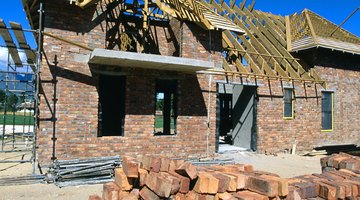How to Texture OSB Board
Oriented Strand Boards (OSBs) have become a popular and cost-effective building material. All the walls of a home can be constructed with OSBs. However, covering this roughly paneled wood with a textured veneer is probably desirable to most home-constructors.

There are several choices one has when choosing a texture with which to mask an OSB.
Things You Will Need
- Drop cloths
- 5 gallon buckets of sheetrock mud (drywall compound) or powder
- Ribbon mixer
- Paint roller pan
- Paint roller handle with cover and extension pole
- Electric drill
- Crow’s foot stomp brush
- Wide taping knife, about 10 inches
- Narrow taping knife
- Putty knife
- Mud pan
Using the Roller Method
-
Cover the floor with the drop cloths. Put half the mud in a bucket and slowly add water, mixing it with the ribbon mixer, until it has the consistency of a milk shake.
-
Pour the watered-down mud into a roller pan. Roll the roller in the pan until it is evenly coated with mud. Roll the mud onto the wall. This is where you can be a bit creative. Play with rollers with different naps and push with different amounts of pressure at different speeds until you get the texture you like.
-
Start rolling the mud onto the walls in a corner and work your way around the room. To add more interest, you can go back around the room a second time, adding random diagonal rolls to the wall to add more interest.
Using the Knockdown Method
-
Cover the floor with the drop cloths. Put half the mud in a bucket and slowly add water, mixing it with the ribbon mixer, until it is a bit thicker than a milkshake. You may have to play with different consistencies until you find one you like.
-
Dip the crow's foot brush into the bucket of mud so that the face of the brush is completely coated.
-
Push the crow's brush onto the wall and then drag it along the wall until there is no mud left to drag. Start in one corner and work around the room, overlapping as you go. You may need to use the narrow taping knife and putty knife as you get to tight spaces around corners and door frames.
-
Drag the 10-inch taping knife at a 45-degree angle over the peaks in the mud, flattening them. If you need a visual: the mud should look like the tops of the Rocky Mountains before this step and like flat plateaus, afterwards. Again, you may need to use the narrow taping knife and the putty knife as you get to the tight spaces around corners and door frames.
The Drip Cap
- Oriented Strand Boards (OSBs) have become a popular and cost-effective building material.
- All the walls of a home can be constructed with OSBs.
- Cover the floor with the drop cloths.
- Put half the mud in a bucket and slowly add water, mixing it with the ribbon mixer, until it is a bit thicker than a milkshake.
- You may need to use the narrow taping knife and putty knife as you get to tight spaces around corners and door frames.
References
Writer Bio
Jennifer Reid has been writing since 1998, including articles for "The Winchester Star," academic and creative writing journals such as "Fete" and "E" and eHow articles. She is also a high school teacher, educating students in the arts of writing, reading, and publications. She graduated from The College William and Mary with a Bachelor of Arts in English and secondary education.
Photo Credits
- Goodshoot/Goodshoot/Getty Images
- Goodshoot/Goodshoot/Getty Images
More Articles



